Steven Pressfield's Blog, page 73
February 12, 2016
Girl Scouts, Pot and Thinking Outside the Obvious
A Girl Scout in Los Angeles made the LA Times this week for setting up shop outside a pot dispensary. She sold 117 boxes within two hours, almost a box a minute.
Let’s pretend for a second that there aren’t adults in favor and adults against this young lady’s location choice — and just look at the location.
It’s an example of thinking outside the obvious.
For decades Girl Scouts have been going door-to-door throughout their neighborhoods and camping out in front of local grocery stores, Walmarts and other “family friendly” locations. These are the obvious locations — sell where other families might shop themselves.
When it was my turn, my sale-to-minute rate was along the lines of one box sold to every 20-to-30 minutes spent knocking on doors. That rate decreased as my age increased. The old lady on the corner had a large heart and an open wallet for the eight year old, but that 13 year old was shit out of luck because other eight year olds had taken her place…
Same low sales rate when selling in front of stores. Store shoppers weren’t there for Girl Scout cookies, and they usually didn’t arrive hungry, so cookies were often a pity or impulse buy — or because the seller was their daughter, granddaughter, neighbor, niece, best-friend’s daughter, niece’s best friend’s daughter, “best friend’s sister’s boyfriend’s brother’s girlfriend[‘s]” sister…
So where else to sell the cookies? I’ll leave that specific answer to the parents and Girl Scouts, but it’s a question to think about when selling your book or painting or film or album — or whatever it is you’ve created.
Years ago, I’d hear sales reps discuss “special sales,” which were along the lines of the pot dispensary. They were sales into places that weren’t bookstores, but sold books. Think Wholefoods, Restoration Hardware, Urban Outfitters, etc. — stores that either have a small book section or that use books as props, but also sell them.
I wouldn’t call them “special” anymore as they’re the way and not just a special way these days.
The mistake made with special sales is pitching places that seem obvious to the seller (Girl Scouts selling in front of grocery stores) but aren’t where some prime buyers are shopping (pot dispensary).
For example, I’ve listened to publisher after publisher complain about not getting their military-related/themed books into military base exchanges. To them, the most obvious audience is the active-duty military community. Afterall, if someone is in the military, they must spend all their free-time reading about military-related topics, too, right? And, the obvious place for them to buy these books is within the military exchange stores.
No.
Hit them where they hang out — not just where they work.
It’s the same idea behind seeing a Star Wars-themed book within the Star Wars-themed bedding display in Pottery Barn for Kids. The store itself isn’t the obvious go-to store for Star Wars fans, but… They shop there, too.
A few years ago I spotted a copy of a book from the Art of Manliness team, smack dab in the middle of a window display for a Las Vegas men’s store. It served as both decoration and product. Added to the window dressing and was for sale, too.
When you pull your possible sales list, don’t ignore the obvious. But, if a location and/or audience is obvious to you, it/they’re likely obvious and over-targeted by others, too.
What’s the place where can you sell almost one unit a minute in two hours?
February 10, 2016
The Difference Between Subject and Theme
What do we mean when we say a book or a movie is “about something?” This question is a lot trickier than it seems.
Did you see the movie The Break-up, starring Jennifer Aniston and Vince Vaughan? A facile answer regarding this film would be, “It’s about a break-up.”
Wrong.
The subject is a break-up.
The theme is something else entirely.
The subject of the Jurassic Park movies is dinosaurs.
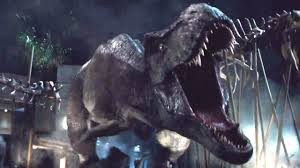
The subject is dinosaurs. The theme is, “Don’t mess with Mother Nature.”
The theme is, Don’t mess with Mother Nature.
The subject of Out of Africa is Karen Blixen’s experiences in Africa.
The theme is possession. “Is it possible,” the movie asks, “for a person to truly own something—a farm, a lover, her own fate?”
The theme of Out of Africa in statement form is, “It is not possible to own anything, and the harder we try, the more certain we are to lose what we wish to hold.”
A theme does not have to be true in all instances.
We can write one book with Theme X, then follow it up with another with Theme Opposite-of-X.
Sometimes a writer or filmmaker will deal with the same theme over and over. David O. Russell (one of my faves) seems to love the theme, “An individual, no matter how beset by his/her own self-sabotage and the sabotage of their family, can triumph if he/she is passionate enough, brave enough, and creative enough.” The Fighter, Silver Linings Playbook, Joy.
A theme can be totally unoriginal and still work beautifully. It can be a platitude. It can be a cliche.
“Love conquers all.”
“Might makes right.”
Remember the advertising line for the first Rocky?
His whole life was a million to one shot.
That statement is not far off from the movie’s theme, which is in truth a word-for-word statement of the American dream:
The sorriest bum in the street is capable of greatness if he’s just given the chance.
The theme of Casablanca is another cliche. “It’s better to work for the good of the group than for your selfish personal ends.”
There’s nothing wrong with your theme statement being a cliche. In many ways it’s better. Why? Because it means your theme has broad applications. It’s universal. It applies to everybody.
Part of the reason Rocky was a hit was that so many people could identify with its theme.
A theme should have multiple layers. We should be able to interpret it on the personal level, the political level, even the spiritual level. The more levels the theme works on, the more powerful it is.
Casablanca came out in 1941, while the U.S. was in a raging internal debate over whether or not to enter World War II. When in the film Humphrey Bogart declared
I stick my neck out for nobody
and
I’m the only cause I’m fighting for
he was speaking on the personal level. But his words were understood by the audience on the political level as well. He was giving voice to the powerful “American First” sentiment then prevalent in the country.
Bogie was also stating one side of the movie’s theme. The hero, remember, embodies the theme. How he or she acts in the final crunch becomes the movie’s statement of the theme.
In the climax of Casablanca, when Bogie forsakes his own selfish ends (to fly off to safety with his former lover, Ingrid Bergman) and instead puts Ingrid on the plane with her husband, the gallant Resistance fighter Paul Henreid, while he himself remains behind to join the fight against fascism, his actions state the movie’s theme not just personally, but politically.
Level One: Bogie elects to act for the greater good.
Level Two: America should do the same. It should get into the war.
Why is theme so important?
Because it gives a story focus and depth.
We’ve all read a millions sagas about plucky Moms and punchy prize fighters and self-centered gamblers/con men/operators. (In other words, subject). But when the struggles of these characters are given focus by the right theme, and when that theme contains a second or even a third level, then the story’s power is magnified and its emotional wallop is doubled and tripled.
Which leads us to the next aspect of theme—cutting everything that is not on-theme.
We’ll talk about that next week.
February 5, 2016
Releasing Your Voice/s

Too Cool for School
Over at the Story Grid Podcast, one of our most popular episodes concerns how writers approach Narrative Device.
What exactly is Narrative Device?
Narrative Device is the choice the writer makes about the qualities of the being that will “tell the Story.”
Should the writer write in the first person? I met a man from Istanbul who had a black moustache.
Or should the writer choose third person? When Temple Eliot stepped off the Orient Express, the first to attract her attention was a man with a black moustache.
Or even second person? You are not the kind of person who finds facial hair appealing, so why did the man with the black moustache seize your imagination?
Narrative Device is another way of qualifying the writer’s “voice.” And any writer worth her salt will tell you that once you crack the Narrative Device, the Story almost writes itself.
Consider the following poem by Charles Bukowski:
there’s a bluebird in my heart that
wants to get out
but I’m too tough for him,
I say, stay in there, I’m not going
to let anybody see
you.
there’s a bluebird in my heart that
wants to get out
but I pour whiskey on him and inhale
cigarette smoke
and the whores and the bartenders
and the grocery clerks
never know that
he’s
in there.
there’s a bluebird in my heart that
wants to get out
but I’m too tough for him,
I say,
stay down, do you want to mess
me up?
you want to screw up the
works?
you want to blow my book sales in
Europe?
there’s a bluebird in my heart that
wants to get out
but I’m too clever, I only let him out
at night sometimes
when everybody’s asleep.
I say, I know that you’re there,
so don’t be
sad.
then I put him back,
but he’s singing a little
in there, I haven’t quite let him
die
and we sleep together like
that
with our
secret pact
and it’s nice enough to
make a man
weep, but I don’t
weep, do
you?
I’d bet if Bukowski were around today and someone asked him to pick a piece of writing that best reflects his battle hardened true voice, it would be that poem.
The legend of Bukowski reeks of spilled beer, cigarillo smoke and the acrid sweat of obliterative rage. But in this poem, Bukowski the artist stripped away the BS and revealed the marshmallow human being underneath.
He did that by nailing the Narrative Device, in this case writing a confessional Story as the cynical performance artist known as the “writer Charles Bukowski.”
The storyteller of the poem is the authentic Bukowski, the guy who got up in darkness every morning before his shift at the post office to write. The other Bukowski, was a persona, one he no doubt enjoyed and hid behind to protect his bluebird from external third party assault, something that as a child he was all too familiar with.
Bukowski’s inner triumph (creating as existential necessity, not “look at me” exhibitionism) is the job we as writers and artists have signed up for. To shuck our “writerly” BS, examine our internal landscapes to such a degree that we recognize our multiple personae and find ways to give them the external stage, the page. Let them tell our stories for us. That’s why they’re in us.
To let those birds out even though their songs torment us.
Narrative Device is just the technical term for discovering how to get the hell out of the way and letting those bluebirds sing.
February 3, 2016
What is Your Novel About?
I was talking to a friend who runs a successful Hollywood literary agency. She represents screenwriters. Before she opened her doors, she said, she spent a year doing nothing but reading scripts, searching for promising young writers. She read well over 500 screenplays.
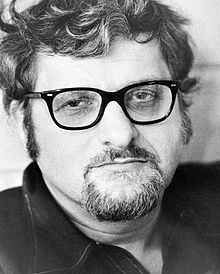
Paddy Chayefsky, the only three-time solo Oscar winner for Best Screenplay
“How many,” she asked me, “do you think were worth representing?”
Before I could reply, she answered.
“None.”
I believe her.
I’ve read a boatload of screenplays and novel manuscripts myself. Many have interesting, even brilliant premises. Fascinating characters abound; there’s lots of clever dialogue, surprising plot twists, mind-blowing set-pieces. And a lot of what I (and my agent friend) have read is really good writing.
But almost none of it works.
Why?
What’s missing?
“The scripts,” my friend said, “were almost never about anything.”
Theme.
She was talking about theme.
This is a subject I’ve become rabid about. I’m not even sure why. For years I myself wrote without the slightest clue of what theme was. I couldn’t have defined it if you had hung me by my thumbs over a seething volcano. I had no idea that it was important. I didn’t even know what it was.
I was just like all those failing writers. In fact I was failing myself.
Robert McKee tells the following story (forgive me; I’ve cited it before).
As a young writer-director he got the chance to interview the great playwright and screenwriter Paddy (“Network,” “Marty” “The Hospital”) Chayefsky, the only three-time solo Oscar winner for Best Screenplay.
As soon as I figure out what the theme of my play is [said Chayefsky], I type it in a single line and Scotch-tape it to the front of my typewriter. After that, nothing goes onto the page that isn’t 100% on-theme.
For me, that quote was a life-changer. The light bulb went off. I finally got it.
I’m going to take the next few weeks on this blog and address nothing but theme.
Maybe you’ll hate this subject. Maybe I’ll bore you to death. Maybe you’ll say to yourself, “I dunno why this dude keeps going off on this. It’s all so obvious.”
Clearly it isn’t obvious, or my literary agent friend wouldn’t have read five hundred scripts and come up with zero that she cared to represent.
Okay.
What is “theme?”
Why is it so important?
How can five hundred writers bang out scripts—scripts that in many other respects are excellent, or at least interesting—that are about nothing?
Let’s start with a corollary to that question.
“What happens when a script is about nothing? (And I don’t mean like Seinfeld, which is decidedly not about nothing.) What does a novel with no theme feel like?”
It feels empty.
It feels hollow.
When you set it down, your expression is a blank stare. You feel like you’ve just consumed a meal that provided zero nutrition. You wonder, “Why did the writer even write this at all?”
Here’s a related concept that also helped me tremendously when I began to grasp it:
Every major character must represent something that is greater than himself or herself.
Jay Gatsby represents something.
Daisy Buchanan represents something.
The green light at the end of Daisy’s dock represents something.
Atticus Finch represents something.
Don Corleone represents something.
Huckleberry Finn represents something.
The 500 protagonists in my literary agent friend’s screenplays represented (I’m guessing) nothing but themselves. X was X. X did not stand for Y or Z. That’s why the scripts felt so hollow. That why they left the reader feeling starved and cheated.
Here’s a third related principle:
The protagonist represents the theme.
Am I boring you yet? If this is tedious to you, if you feel your eyes glazing over as they might in some soporific graduate seminar, may I suggest that you release all hope or ambition of succeeding (or even having fun) as a writer.
This stuff is seminal.
You have to know it.
Forgive me for ranting. Like I said, this subject makes me insane.
Back to characters, back to theme.
A story, any story, has to be about something. It must have a theme.
The hero of the story represents the theme.
The villain represents the counter-theme.
In the climax, hero and villain clash to the death (at least figurative death) on-theme.
In the next few weeks we’ll get into this subject in excruciating detail. But let me sign off this post with a single thought.
It is very, very hard to figure out your theme.
It’s back-breaking, brain-busting labor.
Resistance becomes monumental.
Even Paddy Chayefsky had to struggle. (Note how he says, “Once I figure out the theme … ” Meaning he did not know it at the start. He was operating on instinct.)
Theme is hard work.
But you and I have to do it. There’s no getting around it—unless we want to be one of those five hundred in our literary agent’s reject pile.
[P.S. Thanks to Juan Taylor, who suggested this subject and urged that I try a few posts addressing it.]
January 29, 2016
Finding Atticus
 After Atticus pulled Calpurnia away from Aunt Alexandra and the Maycomb missionary circle ladies, Aunt Alexandra asked Miss Maudie when it would stop. (Chapter 24, To Kill A Mockingbird)
After Atticus pulled Calpurnia away from Aunt Alexandra and the Maycomb missionary circle ladies, Aunt Alexandra asked Miss Maudie when it would stop. (Chapter 24, To Kill A Mockingbird)
“I can’t say I approve of everything he does Maudie, but he’s my brother, and I just want to know when this will ever end.” Her voice rose: “It tears him to pieces. He doesn’t show it much, but it tears him to pieces. I’ve seen him when — what else do they want from him, Maudie, what else?”
“What does who want, Alexandra?” Miss Maudie asked.
“I mean this town. They’re perfectly willing to let him do what they’re afraid to do themselves – it might lose ‘em a nickel. They’re perfectly willing to let him wreck his health doing what they’re afraid to do, they’re —“
“Be quiet, they’ll hear you,” said Miss Maudie. “Have you ever thought of it this way, Alexandra? Whether Maycomb knows it or not, we’re paying the highest tribute we can pay a man. We trust him to do right. It’s that simple.”
It wasn’t just that Maycomb trusted Atticus to do right, they expected him to DO, period. They knew he was a man of action, that he’d do something – and that they’d be alright with whatever that something was because they knew well what to expect of Atticus.
Atticus didn’t put on airs, pretend to be something he wasn’t. Just as Miss Maudie liked to comment, he’s “the same in his house as he is on the public streets.”
I’ve not read Go Set A Watchman, so I can’t comment on the Atticus of that story, but the Mockingbird version seemed even-handed, fair and loving to his kids, and skilled without wearing his accomplishments for all to see, like a Saran Wrap wallet. Instead, his accomplishments were tucked away, his skills held close, available to be pulled out for use within his life, rather than as the forces driving his life.
In a time with such a “me” focus, it’s reassuring to think of someone who is a doer, without talking about being a doer; someone who goes to court, instead of changing their Facebook profile picture in a show of solidarity with someone who is in court; someone who is willing to take risks because it is the right thing to do; someone who ignores a troll who spits in his face because he understands the troll’s motivations; someone who won’t be heckled or stopped by hate; someone who continues to evolve, not perfect, but open to change.
It’s a shame that someone is fiction.
Think Bradbury and Bowie will send him down from Mars to us?
A nice thing to think about.
(*I read Mockingbird in one sitting while stuck in the airport during last week’s East Coast snowstorm. Almost 30 years after my first reading. If your Mockingbird gap is as large, go back to revisit it. Experience and time, and the lack of a high school English teacher forcing her theories, made for one of the best reads I’ve had in a long time. Finding Atticus was like revisiting an old friend. He reminded me of the importance of doing the hard work — and of the equally important work of the Calpurnia’s, Miss Maudie’s, Scout’s and Jem’s. Different roles. All important.)
January 27, 2016
Choreographing a Fight Scene
The first movie I ever got sole writing credit on was one of the worst pictures ever made. I’m not kidding. I won’t even tell you the title because if I do you’ll lose all respect for me.
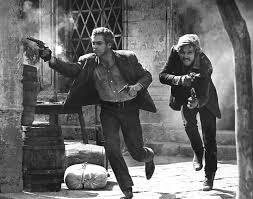
Paul Newman and Robert Redford in “Butch Cassidy and the Sundance Kid.” No, this is not the movie I’m talking about. But this shoot-out DOES illustrate the principle.
But …
But I learned one enormous lesson on that movie.
We were shooting a gunfight scene. The scene took place in a warehouse. It involved the hero and his girlfriend and about a dozen bad guys. Dudes were dropping from the rafters, plunging through skylights; cars were blowing up, the warehouse was going up in flames, not to mention gunfire was ripping in all directions, coming from half a dozen different kinds of weapons—.45s, nine-millimeters, shotguns, machine guns.
In the script, all it said was “X shoots it out with a dozen bad guys.”
But in actually filming the scene, the stunt coordinator and the Second Unit director had to block out and choreograph every gunshot, every fall, every explosion, every vehicle crash. It was an amazingly complicated operation, with absolutely nothing left to chance.
Here’s what the Second Unit director told me:
Any time you film a guy firing a gun, you MUST also film where the bullet hits and what effect it produces. Otherwise the scene becomes totally confusing to the audience. And it looks fake.
I had never thought about that before. But I could see at once that the director was absolutely right.
I thought about fist fight scenes, even sword fights. Don’t you hate it when one guy slashes with a samurai sword and you don’t see where the blade goes or what it hits? Or those horrible fakey kung-fu fights that just look like a blur of kicks and punches and you can’t tell who’s winning or losing?
I thought about dance scenes. How bogus is it when you see the star start to do a pirouette or a flip and then the camera cuts to someone who’s obviously a stunt double doing the move, then they cut back to the star (close up of course, so you can’t see her body in motion) as if she had just performed the move herself.
Bad.
Bad!
I thought about the great old Fred Astaire-Ginger Rogers movies (or Fred with Cyd Charisse or Eleanor Powell or Rita Hayworth, or Fred with anybody) and how not only does the camera never show anything but both dancers head-to-toe, but it never cuts away. Every scene is shot in one take, so you know there’s no cheating. This is Fred. This is Ginger. They really did it, and with no tricks.
The same principle applies, of course, to any setup and payoff in any story. The old saw that says
If you show a gun in any scene, that gun has to be fired in some subsequent scene
could not be more true.
If the gun is not going to be fired in the story, don’t show it at all.
If you start any narrative thread anywhere in the story, that thread has to be paid off later. Otherwise don’t start it.
I remember watching the final cut-together version of the shoot-out in the warehouse. Forget that the movie was terrible. The scene played great.
One Bad Guy pops up from behind a barrel and fires a shot; we see the bullet strike and shatter the windshield of the car the hero and his girl are hiding behind—and we see them react as the glass blasts all over them. Next a villain plunges through the skylight firing a machine gun. Rat-a-tat: a row of bullet strikes is stitched along the wall, just missing hero and girl as they flee.
The scene looked absolutely real and made complete sense. You could follow what was happening. The action looked authentic and convincing.
The director’s axiom worked.
When you fire a gun (or throw a punch or open a narrative thread), make sure the audience sees where it lands and what effect it produces.
Otherwise the scene looks confusing and fake. It looks like a cheat.
January 22, 2016
The Iceman Cometh

No Steve, No Ice Rink
Many moons ago when I worked for “the man,” I’d reached a state of utter burn out. There was absolutely no water left in my creative well. I’d peered into the abyss and fallen in. Even mine own private Resistance had gone on vacation. Even he knew I was toast.
I’d just finished a project with a very high profile celebrity that required an inordinate amount of humility. The celebrity would have none of my rational editor-speak or my insistence on linear storytelling. To make matters worse, the usual tools to enforce my power (really the corporation’s power) over the artist (money and contractual obligations) were useless.
The celebrity (someone with an extremely high I.Q. and an Übermensch sense of self…except when he felt threatened or unsure of himself…which was quite often, fun right?) wisely refused to sign the seven-figure contract I’d negotiated with his agent or accept one penny from the company until he was personally satisfied with the manuscript. He wouldn’t be strong-armed by the publishing machine. God knows he’d verbally agreed to the terms of the deal and had publicly announced his intentions of writing the book, going as far as appearing at the Book Expo convention with much hoopla.
But he simply refused to sign the contract until he was damn good and ready.
You may find it crazy for a publisher to move forward on a book without a signed contract, but publishers often agree to a project, announce it, catalog it, create a cover for it, and set a lock down pub date for it…all the while not having a “signed agreement” in place. It just takes a long time for lawyers to work out the specific language of the contracts and because large sums of money for these projects are at stake, it is very rare for them to go south. Who walks away from a million dollars guaranteed over a “returns clause?” The deals eventually get done long before pub date, checks clear, and all’s well.
Not so in this case.
In fact, two weeks after the book had been published and was on The New York Times bestseller list, I drove to this celebrity’s house, put the paperwork on the hood of my rented car and told him that I’d never ask him for another thing if he’d just sign the damn thing.
Funny that I had to “call in a favor” so that the person in question could be paid more money than I’d made in my career…
The absurdity of the situation did not escape my notice, especially after my reward for keeping the thing alive and actually getting it in print to reach the bestseller list was just getting to keep my job. Oh and a nice bottle of wine.
Here’s the thing:
The place where I was working had just undergone a “regime change.” That’s a nice way of saying that the publisher had been fired and another one had been brought in to right the ship. But what was weird was the “new” publisher turned out to be the previous publisher before the one who had just been fired.
Huh?
It was a sort of George Steinbrenner/Billy Martin kind of situation where the previous publisher had a few bad seasons and was “promoted” by the corporate hierarchy to a position overseas. Big Big corporation by the way. He was probably under contract for a lot of money so the corporation shipped him to parts unknown to ride it out until he deposited his final check.
Another publisher (the one who hired me) was brought in to right the listing ship that the previous publisher had left…(now the returning new publisher…).
The publisher who had hired me had taken the company in a more “commercial” direction…meaning more big thrillers etc. on the list…hence my being hired. But she’d had mixed results and she wasn’t a very good schmoozer either. So she was canned (and all editors she’d hired were canned too…with the exception of moi) and the former publisher came back to restore the literary gravitas of the place, while he’d also been tasked with increasing net revenue. No easy feat. He actually pulled it off.
You can see why being a publisher ain’t what it’s cracked up to be.
Just as an aside, I liked both publishers. The boss who hired me was an old school brassy force of nature who’d risen from the secretarial pool to the corner office when women were still being called “girls” and my new boss (the guy who used to run the show brought back to run it again) turned out to be a real mensch.
But I had a boss in between myself and the publisher too and let’s just say we had a complicated relationship…more on that in a minute.
So what drove me into the abyss?
While I’m confident the celebrity liked working with me (we’re still distantly friendly), he could have cared less about my “career” or the fact that his failure to deliver the book when he said he would could easily be grounds for my firing. That’s not a criticism either. That’s the right attitude for an artist; serve the art not the peripheral forces demanding attention around the art.
Remember that this was a “big book” for the company too. It would drive a lot of revenue into the coffers just before the end of the fiscal year. My inner Sammy Glick knew that if I could get this thing together, I’d earn a lot of respect from my bosses and maybe I could become one someday soon myself…. So I kept making promises.
“Sure it’s going great! Don’t worry!”
“Book’s due to the printer next week? Oh don’t sweat it, we’re just doing some little interstitial tinkering.”
“You absolutely need by Friday? Sure, no problem!”
I worked three days and nights straight…didn’t leave the office…and stayed up all night long the night before the book was due on press with the celebrity and his equally suffering co-author to hit the deadline. But we did make it and we did sell a lot of copies.
So after that wild ride, I should have been over the moon happy with the success of the project, right? I should have been energized to jump back into the fray and push that old rock up the hill a little more right?
Instead, I wanted to crawl into a shallow hole, cover myself with soft, handmade quilts and sleep for seven and a half months.
About a week after I’d gotten the celebrity to sign the contract, he called me and asked me if I wanted to hang out and play golf. He’d fallen into a bit of a depression himself after the whole thing too and like freed hostages surrounded by people who just didn’t get what they’d been through, he wanted to have a mini-reunion. To laugh it all out of our systems.
So I went to see my immediate boss just to let him know I’d be taking off the rest of the day to hit the links with the celebrity. You know to decompress?
He did me a great favor that day by refusing to grant my request for the afternoon off.
I realize today (not at the time of course as I was blinded by Black Irish rage-fury that thankfully I was able to suppress before I expressed it) that my boss did what he had to do. It wasn’t personal.
The corporation that employed me at its discretion and of which my boss was its immediate representative wouldn’t benefit from my playing golf with the celebrity now. Before the guy signed the contract? Sure. But now that he had, the corporation had already realized whatever profit it would get out of that relationship. Time to move on.
What the corporation needed from me now, and let’s not forget who paid me, was to plow into the next project. Not wallow in the past.
If my boss were to approve my 18 holes of downtime, he’d be sending a dangerous message to me and to my fellow employees. That message would be that rewards and favor will come to editors who take wild risks, make promises they shouldn’t, and put the company in compromising positions. I was guilty of all of those sins.
That is not a good business model for a corporation. The whole thing could have easily blown up spectacularly. I was lucky it didn’t. I shouldn’t be rewarded for doing such a thing. I needed to be warned not to stretch so thinly. To take the smallest risks necessary for the most monetary gain. Not big ones… And so I was.
So what does this have to do with the photo of the skating rink?
Not so long ago (I confess I’m still in the midst of it) I faced another burn out. This time I called my business partner and told him all about it. How I’m finding myself physically resisting the plunge into the next thing. How I need to get the Hell away from Story Story Story for a while. That I need to do something else with my hands for fun that has nothing to do with Editing or Writing or Teaching etc.
Now, this business partner is known for his defining the very concept of artistic “Resistance.” He’s known for kicking people in the ass, for putting forth that it is through grinding hard work and only for the work’s sake that will we ever be touched with muse-inspiration. That excuses are Resistance’s furies. Isn’t the mother of all excuses “I’m burned out?” Good luck getting this guy’s sympathy.
And keep in mind that this new “corporation” is a two-guy only operation. When one peters out, the other is left holding the bag. There aren’t any side businesses or autonomous imprints in the company that are going to pick up the wastrel’s slack.
After I rang off from that dreaded call, I had the energy to plan and build an ice skating rink for my kids. From scratch. I can still hear the snickers from the guys at Home Depot when I told them what I was going to do with “all that lumber.” I lifted every board, strung all the lights, and turned every screw. And not once did I think about inciting incidents, progressive complications, crisis, climax or resolution.
That’s what the photo is, a moment at the end of last night’s ice time, just after I poured a nice new sheet.
There’s no denying that change require loss. Walking away from an esteemed branded institution that enables rubbing elbows with celebrities is a surefire way NOT to get your calls returned. But your kids will trade that loss for a skating rink any day of the week.
The only problem for me is that I skate as well as I golf.
January 20, 2016
Make Your Hero Suffer, Part Four
We as writers have been admonished a thousand times that a character must have an arc.
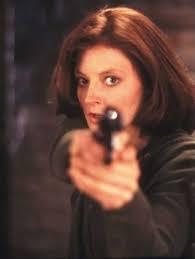
Jodie Foster as Clarice Starling in “The Silence of the Lambs.” Forgive me, Shawn, for borrowing your heroine.
For sure, our hero has to have one. She must change through the story. The more she changes, the better.
Yeah, that’s true.
But change alone is not enough.
That movement has to be (you’re ahead of me, I know) on-theme.
The hero has to learn something through her suffering. But it’s more specific even than that. She has to advance and become more conscious not just in general or willy-nilly, but in line with what the story’s about.
What is a character’s arc anyway?
The term is well-chosen, I think, because of the image it evokes—that of a rising-and-descending trajectory from one side of a hemisphere to the other. West to east. 180 degrees.
An arc has symmetry. It doesn’t move randomly, but pole-to-pole. It transits from plus to minus (or vice versa). It produces a U-turn.
An arc is a hero’s journey in the sense that it “returns,” if not to where it started, then to the point directly across from that point of origin.
What happens along that arc?
What happens is suffering.
In The Silence of the Lambs (as Shawn has so meticulously and skillfully broken the narrative down for us in The Story Grid), Clarice Starling’s interior arc is one of disillusionment. She, the FBI trainee, starts out believing that the Bureau is fair and that the wider world is a level playing field. If she works hard and produces results, she believes, she will be rewarded. The system is honest, she believes.
By the end of the book Clarice has been betrayed by her boss, locked out by her superiors; she’s been fired, pulled off the Buffalo Bill case, cast into the outer darkness. That’s her suffering. She’s trying to save a young woman’s life (the latest kidnap victim, Catherine Martin, whom the psycho killer is about to murder and mutilate) and all the system does is ignore her, degrade her, and stand unfairly in her way.
And yet she prevails. On her own, employing only her own resources, Clarice locates the villain, enters his lair, and dispatches him. By her own wits and in the face of monumental adversity, she saves the damsel in distress.
So what is Clarice’s arc? What is her suffering? How does she change?
She changes on-theme. Her inner worldview goes from False (but Positive) Belief to Disillusionment, even Despair, to True (although Negative) Perception.
Is this an “unhappy” ending? Yeah, in the sense that Clarice finds herself at the end of the story without illusions, on her own, with no mentor, no sponsor, no organization to which to belong and no immediate hope of “advancement within the system.”
On the other hand, this clearing out of self-delusion has opened her to the possibility of true self-belief.
The best kind of suffering in a drama (or a comedy) is suffering brought on by the protagonist’s own original blindness. Why? Because that deficit of awareness carries with it a built-in hero’s journey and a made-to-order arc. Oedipus will go from his own arrogant hubris to full excruciating awareness of his crimes. Shane will progress from his dream of living a normal life to the realization that he can’t escape the weight of his gunslinging past.
The hero’s arc is the 180-degree trajectory of his or her suffering as he/she is compelled by events to perceive and to accept the truth.
This truth was present from the start or even before. Its location was at the pole opposite from the one at which the hero stands in the story’s opening.
The hero’s arc carries her or him from one pole “out and back” to the other. Clarice, Oedipus, Shane—none of them wants to go to that opposite pole. They hate that opposite pole. They’re in total denial of that opposite pole.
That rejection, that blindness is the source of their suffering. And the source, in the end, of their painfully acquired wisdom.
The hero’s suffering produces elevation of consciousness. This is true in fiction and it’s true in real life.
That’s why we need suffering in our stories and why we as writers must have no reluctance about heaping it on our heroes.
January 15, 2016
Bradbury and Bowie: Dancing, So As Not To Be Dead
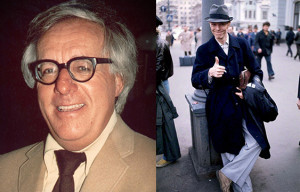
Ray Bradbury and David Bowie. Bradbury image credit: Alan Light. Bowie image credit: www.DavidBowie.com
In “Dancing, So As Not to Be Dead,” Ray Bradbury’s introduction to The Illustrated Man, he starts with a story about Laurent, a waiter in Paris, who spends his life between working and dancing.
“I work from ten to twelve hours, sometimes fourteen,” he says, “and then at midnight I go dancing, dancing dancing until four or five in the morning and go to bed and sleep until ten and then up, up to work by eleven and another ten or twelve or sometimes fifteen hours of work.”
When Bradbury asks how he can do that, Laurent replies:
“Easily,” he says. “To be asleep is to be dead. It is like death. So we dance, we dance so as not to be dead. We do not want that.”
When Laurent asks Bradbury what he does in the morning, Bradbury says he writes.
“Write!” Laurent says, astonished. “Write?”
“So as not to be dead,” I say. “Like you.”
“Me?”
“Yes,” I say, smiling now, myself. “At three in the morning, I write, I write, I write!”
The day after diving into The Illustrated Man for the first time, I read about Cancer hitting David Bowie. Bradbury’s story came to mind, of dancing and dancing and dancing, and writing and writing and writing, so as not to be dead.
If you know only one thing about Bradbury and Bowie, know this: they were ALIVE.
Both were writing and dancing and creating — and always in the direction of roads less traveled.
Toward the end of “Dancing, So As Not To be Dead”, Bradbury returns to his opening story about Laurent:
I end as I began. With my Parisian waiter friend, Laurent, dancing all night, dancing, dancing.
My tunes and numbers are here. They have filled my years, the years when I refused to die. And in order to do that I wrote, I wrote, I wrote, at noon or 3:00 A.M.
So as not to be dead.
And in not being dead, I owe them for keeping me alive.
When I wanted to sleep, their works brought me to life — fought back death, pulling me up like Lazarus. Food for my soul. Fuel for my engine. They trigger that “thing” within me that I’ve often struggled to turn on myself. Read a little Bradbury and within minutes my head is spinning with stories of my own. Jotting down ideas. A little Bowie and I can conquer the world. No wake-up coffee for me. Just some Bowie and Bradbury please.
When I hit “The Exiles” within The Illustrated Man, I was comforted in thinking of Bowie and Bradbury on Mars, mixing it up with other artists (including Dickens, though he sounds like an ass), but without the the book-burning censorship and dangerous thinking that landed Bradbury’s characters there in the first place. More a place where the greats go to keep an eye on the rest of us and send down jolts of inspiration from above.
Thank you Bradbury. Thank you Bowie. You are among the greatest gifts of my life. Will keep the air waves crystal for messages from Mars.
January 13, 2016
Make Your Hero Suffer, Part Three
Continuing our exploration of the protagonist’s ordeal:
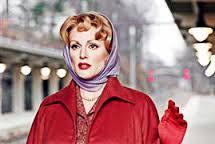
Julianne Moore as a 50s housewife in Todd Haynes’ “Far From Heaven”
Why, we might ask, does the hero have to suffer at all? Why can’t she just be happy? Wouldn’t that work just as well in a story?
Answer: no.
The hero has to suffer because:
Suffering is part of the Hero’s Journey (as articulated by Joseph Campbell, C.G. Jung, and others) and virtually every story is a version of the Hero’s Journey. But more importantly …
Suffering produces insight. Suffering leads to wisdom. Suffering forces the hero to change.
Jack Nicholson changes in Chinatown, Julianne Moore changes in Far From Heaven, Alan Ladd changes in Shane. Each one traverses a hero’s journey. Each one suffers. Each one is altered by his or her suffering.
You, the writer, invent your hero’s suffering for precisely this reason. What ordeal, you ask yourself, can I put my protagonist through that will compel her to deepen her understanding of life and of herself, that will force her to confront some issue she has been either oblivious to or deliberately hiding from, that will make her change and grow (even if that change and growth involve further suffering)?
You ask yourself that because if you didn’t ask it, there’d be no story.
Far From Heaven is not the world’s greatest movie, but it’s a really interesting and provocative one. It was written and directed by Todd Haynes (who just did Carol).
Let’s examine it in terms of the hero’s suffering.
Far From Heaven is a period piece, set in 1957 Connecticut. Julianne Moore is the protagonist. When we meet her at the story’s start, she’s a happy suburban wife with a handsome, successful husband (Dennis Quaid), two beautiful kids, a great house, etc. By movie’s end, her hubby has turned out to be gay, the marriage has imploded, the kids are shell-shocked, Julianne’s broke, with no marketable job skills, not to mention she’s also had a heartbreaking platonic affair with her complex and highly intelligent African-American gardener (Dennis Haysbert) that leaves her not only emotionally devastated but a social outcast to all the other little suburban housewives who had been her friends.
What I love most about this movie is the final visual.
It’s a crane shot, looking down on the center of the suburban town. Julianne Moore is in her station wagon, packed up, with the two kids in back. She is leaving the wreckage of her once-happy life. We don’t know where she’s going (neither does she), what she will do, or how she will survive. The camera pulls back, back, back, widening the shot as the station wagon drives off (Oh, I forgot to say: it’s winter) to heaven only knows where.
Julianne has suffered, and she’s about to suffer a lot more.
Is it an unhappy ending?
Is it tragic?
No, because her suffering has produced wisdom.
Julianne has gone from a blind (or, better, self-blinded), dependent, clueless conformist who is living a lie to a heartbroken but now-eyes-wide-open individual who recognizes her predicament and is, at last, facing the fact that she and only she can create a way out of it.
Suffering elevates consciousness.
Suffering wakes us up.
As we in the audience watch Julianne drive off in her town-and-country wagon we might ask ourselves, “Who would we rather be? One of the brain-dead, affluenza-addled housewives still sipping martinis in Suburbanville—or Julianne, who now at least knows the score and, somehow, someway, will find her way eventually?”
Please note, too, that Julianne’s suffering is totally on-theme.
The theme of Far From Heaven is self-delusion.
Who could be more self-deluded that a happy young wife in the American suburbs of the 50s?
Todd Haynes’ movies (see Carol as well) are usually about a surface reality that is in conflict with a hidden reality. The hidden reality is the real one. The track of the story is from false reality to real reality.
The medium of transition is the hero’s suffering.
Why suffering?
Because it hurts to wake up. It hurts to change. It hurts to have your eyes opened to something you’ve been squeezing them shut against your whole life.
So …
To recap the past three weeks’ posts:
Don’t be afraid to make your hero suffer.
Keep the suffering on-theme.
Make the suffering produce greater consciousness in the hero.
Make the suffering produce change in the hero.
If you can stand it, I’m going to stay on this subject next week too. We’ll talk about that old cliche, the character’s “arc,” and examine how this works with suffering.



